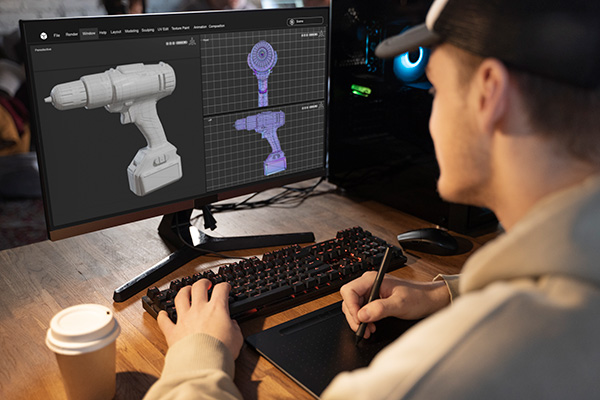3D CAD modeling and simulation-based rapid prototyping with fewer revisions, lower costs, and quicker go-to-market – precision pays off.

Rapid prototyping is an iterative approach to modern product design and development. 3D CAD modeling helps to finetune the iterative approach. It becomes easy to refine designs, print them, and test them quickly and efficiently.
Functional testing before full-scale production saves a lot of time and money. It starts with 3D modeling, simulation-based testing, and prototyping. Various technologies like 3D printing (additive manufacturing), CNC machining, and injection molding are used to prototype designs and optimize them for manufacturing.
3D model-based rapid prototyping is extremely precise and drives accurate testing results. It validates the functionality, durability, and aesthetics before a product goes into mass production and makes the transition smoother and more efficient.
Two types of techniques are used for 3D modeling – direct and parametric. Designers can freely develop and iterate concepts using Direct 3D modeling. Parametric 3D modeling, on the other hand, is ideal for high-precision manufacturing. Both techniques have their pros and cons. Hence, designers combine these techniques to perfect the most complex engineering product designs.
Designers use 3D CAD models to simulate real-world conditions and test the products in a virtual space to identify and correct design flaws before investing in a physical prototype. The simulation-based test results help analyze aspects like – load-bearing capacity, material strength, and resilience. This process minimizes the risk of structural failure and ensures functional reliability, saving a lot of time and costs.
Optimizing 3D CAD models for rapid prototyping involves refining the design to ensure accuracy, efficiency, and manufacturability while minimizing errors and material waste. How do 3D modeling experts achieve this? how is 3D optimised? What are the key considerations: let’s understand
3D CAD models are optimized to support an efficient prototyping process. Optimized 3D models make it easy to identify design flaws and rectify them. Thus leading to an efficient product design.
AI – while ringing in a lot of disruption, has also brought about innovation, ease, and efficiency. Like all other sectors, AI(artificial intelligence), automation, and Next-generation design tools are and will revolutionize how we look at 3D modeling and use it for engineering product development and rapid prototyping.
Cloud-based CAD platforms and digital twin technology will enhance real-time collaboration, ensuring seamless design updates. The power of Artificial Intelligence will make it extremely easy to analyze data from these models to optimize performance, detect failures, and drive future outcomes. 3D models integrated with IoT, AI-powered 3D printing, and automated production systems, streamlining prototyping-to-production workflows will revolutionize the way products and processes are prototyped and optimized – leading to product innovation across industries.
Optimizing 3D CAD models for virtual testing and rapid prototyping is critical. It drives outcomes that will affect the bottom lines. Hence, hiring a 3D modeling and rapid prototyping design service provider who knows the ropes is beneficial. Given the complexity of tolerances, material properties, and manufacturability, professional expertise ensures error-free, optimized designs for manufacturing. Production-ready 3D models for printing, CNC machining, or injection molding will reduce costly iterations and lead to seamless manufacturing.

About the Author:
Rajan Kumar Patel is the Co-Founder of ZetaCADD Engineering Services, based in Ahmedabad, Gujarat. With a Bachelor’s degree in Mechanical Engineering and over 8 years of experience in the field, Rajan leads a team of 20+ CAD engineers at ZetaCADD. His expertise spans 3D CAD design, product development, reverse engineering, sheet metal design, and millwork joinery shop drawings.
Rajan is dedicated to delivering innovative and cost-effective engineering solutions that meet international standards. His technical proficiency includes SolidWorks, AutoCAD, SWOOD, and Homag iX, with a strong emphasis on Design for Manufacturing (DFM) and Design for Assembly (DFA). Prior to founding ZetaCADD, Rajan held key roles in design engineering at HiTech iSolutions LLP and Brightech Valves and Controls Pvt Ltd., where he honed his skills in mechanical design, project management, and client coordination.
In this episode, I sat down with Beejan Giga, Director | Partner and Caleb Emerson, Senior Results Manager at Carpedia International. We discussed the insights behind their recent Industry Today article, “Thinking Three Moves Ahead” and together we explored how manufacturers can plan more strategically, align with their suppliers, and build the operational discipline needed to support intentional, sustainable growth. It was a conversation packed with practical perspectives on navigating a fast-changing industry landscape.